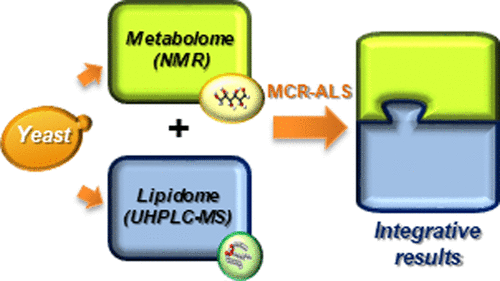当前位置:
X-MOL 学术
›
J. Proteome Res.
›
论文详情
Our official English website, www.x-mol.net, welcomes your feedback! (Note: you will need to create a separate account there.)
Deciphering the Underlying Metabolomic and Lipidomic Patterns Linked to Thermal Acclimation in Saccharomyces cerevisiae
Journal of Proteome Research ( IF 4.4 ) Pub Date : 2018-05-09 , DOI: 10.1021/acs.jproteome.7b00921 Francesc Puig-Castellví 1 , Carmen Bedia 1 , Ignacio Alfonso 2 , Benjamin Piña 1 , Romà Tauler 1
Journal of Proteome Research ( IF 4.4 ) Pub Date : 2018-05-09 , DOI: 10.1021/acs.jproteome.7b00921 Francesc Puig-Castellví 1 , Carmen Bedia 1 , Ignacio Alfonso 2 , Benjamin Piña 1 , Romà Tauler 1
Affiliation

|
Temperature is one of the most critical parameters for yeast growth, and it has deep consequences in many industrial processes where yeast is involved. Nevertheless, the metabolic changes required to accommodate yeast cells at high or low temperatures are still poorly understood. In this work, the ultimate responses of these induced transcriptomic effects have been examined using metabolomics-derived strategies. The yeast metabolome and lipidome have been characterized by 1D proton nuclear magnetic resonance spectroscopy and ultra-high-performance liquid chromatography–mass spectrometry at four temperatures, corresponding to low, optimal, high, and extreme thermal conditions. The underlying pathways that drive the acclimation response of yeast to these nonoptimal temperatures were evaluated using multivariate curve resolution–alternating least-squares. The analysis revealed three different thermal profiles (cold, optimal, and high temperature), which include changes in the lipid composition, secondary metabolic pathways, and energy metabolism, and we propose that they reflect the acclimation strategy of yeast cells to low and high temperatures. The data suggest that yeast adjusts membrane fluidity by changing the relative proportions of the different lipid families (acylglycerides, phospholipids, and ceramides, among others) rather than modifying the average length and unsaturation levels of the corresponding fatty acids.
中文翻译:

解析与酿酒酵母热驯化相关的基础代谢组学和脂质组学模式
温度是酵母生长的最关键参数之一,它在涉及酵母的许多工业过程中具有深远的影响。然而,对于在高温或低温下容纳酵母细胞所需的代谢变化仍然知之甚少。在这项工作中,已使用代谢组学衍生的策略检查了这些诱导的转录组效应的最终反应。酵母代谢组和脂质组已通过一维质子核磁共振波谱和超高效液相色谱-质谱在四个温度下进行了表征,分别对应于低,最佳,高和极端温度条件。使用多元曲线分辨率(交替最小二乘)评估驱动酵母适应这些非最佳温度的潜在途径。分析揭示了三种不同的温度曲线(冷,最佳和高温),包括脂质组成,次生代谢途径和能量代谢的变化,我们建议它们反映酵母细胞对低温和高温的适应策略。数据表明,酵母通过改变不同脂质家族(酰基甘油酯,磷脂和神经酰胺等)的相对比例来调节膜的流动性,而不是改变相应脂肪酸的平均长度和不饱和度。其中包括脂质成分,次生代谢途径和能量代谢的变化,我们建议它们反映酵母细胞适应低温和高温的策略。数据表明,酵母通过改变不同脂质家族(酰基甘油酯,磷脂和神经酰胺等)的相对比例来调节膜的流动性,而不是改变相应脂肪酸的平均长度和不饱和度。其中包括脂质成分,次生代谢途径和能量代谢的变化,我们建议它们反映酵母细胞适应低温和高温的策略。数据表明,酵母通过改变不同脂质家族(酰基甘油酯,磷脂和神经酰胺等)的相对比例来调节膜的流动性,而不是改变相应脂肪酸的平均长度和不饱和度。
更新日期:2018-05-09
中文翻译:

解析与酿酒酵母热驯化相关的基础代谢组学和脂质组学模式
温度是酵母生长的最关键参数之一,它在涉及酵母的许多工业过程中具有深远的影响。然而,对于在高温或低温下容纳酵母细胞所需的代谢变化仍然知之甚少。在这项工作中,已使用代谢组学衍生的策略检查了这些诱导的转录组效应的最终反应。酵母代谢组和脂质组已通过一维质子核磁共振波谱和超高效液相色谱-质谱在四个温度下进行了表征,分别对应于低,最佳,高和极端温度条件。使用多元曲线分辨率(交替最小二乘)评估驱动酵母适应这些非最佳温度的潜在途径。分析揭示了三种不同的温度曲线(冷,最佳和高温),包括脂质组成,次生代谢途径和能量代谢的变化,我们建议它们反映酵母细胞对低温和高温的适应策略。数据表明,酵母通过改变不同脂质家族(酰基甘油酯,磷脂和神经酰胺等)的相对比例来调节膜的流动性,而不是改变相应脂肪酸的平均长度和不饱和度。其中包括脂质成分,次生代谢途径和能量代谢的变化,我们建议它们反映酵母细胞适应低温和高温的策略。数据表明,酵母通过改变不同脂质家族(酰基甘油酯,磷脂和神经酰胺等)的相对比例来调节膜的流动性,而不是改变相应脂肪酸的平均长度和不饱和度。其中包括脂质成分,次生代谢途径和能量代谢的变化,我们建议它们反映酵母细胞适应低温和高温的策略。数据表明,酵母通过改变不同脂质家族(酰基甘油酯,磷脂和神经酰胺等)的相对比例来调节膜的流动性,而不是改变相应脂肪酸的平均长度和不饱和度。



























 京公网安备 11010802027423号
京公网安备 11010802027423号